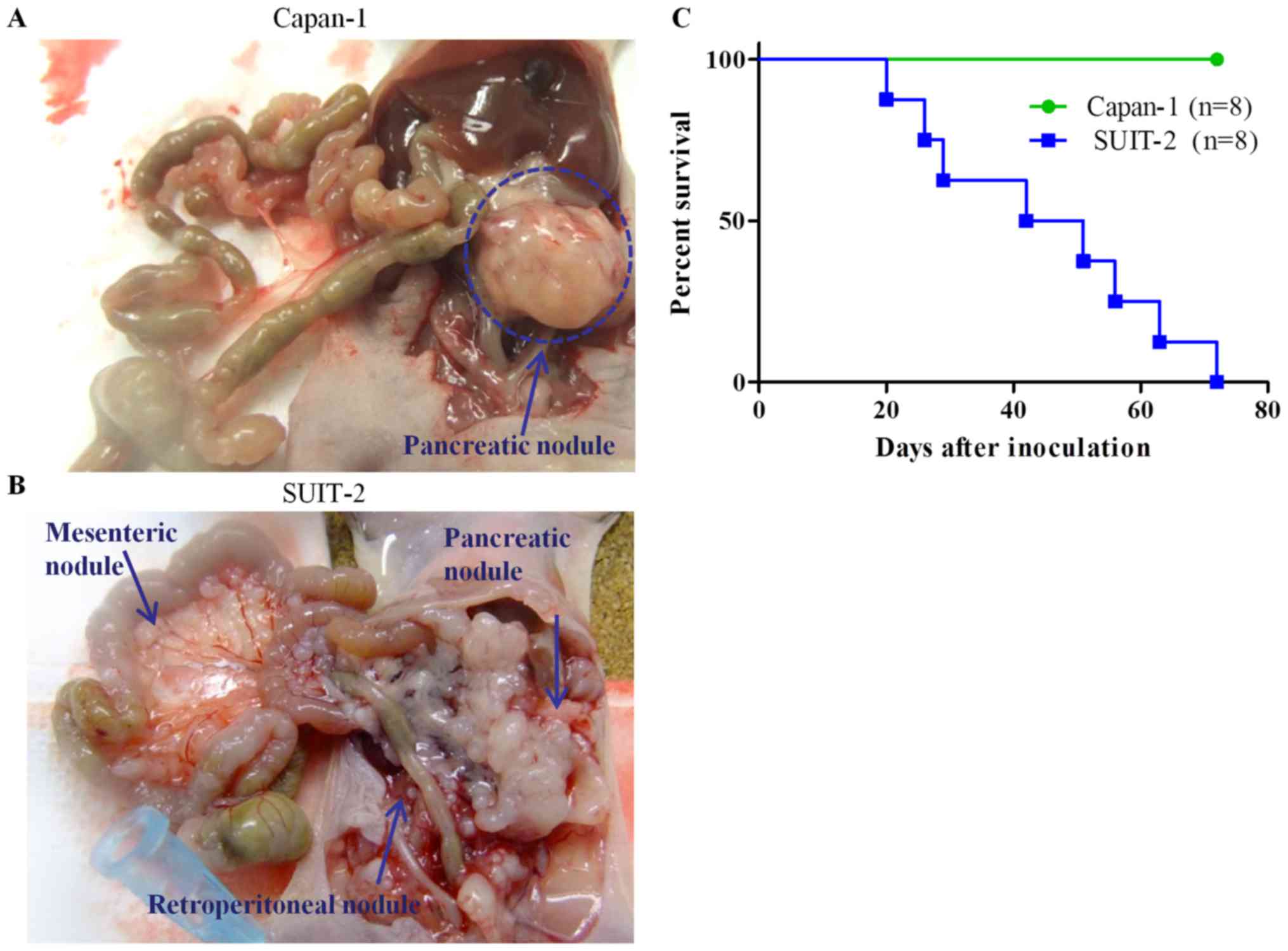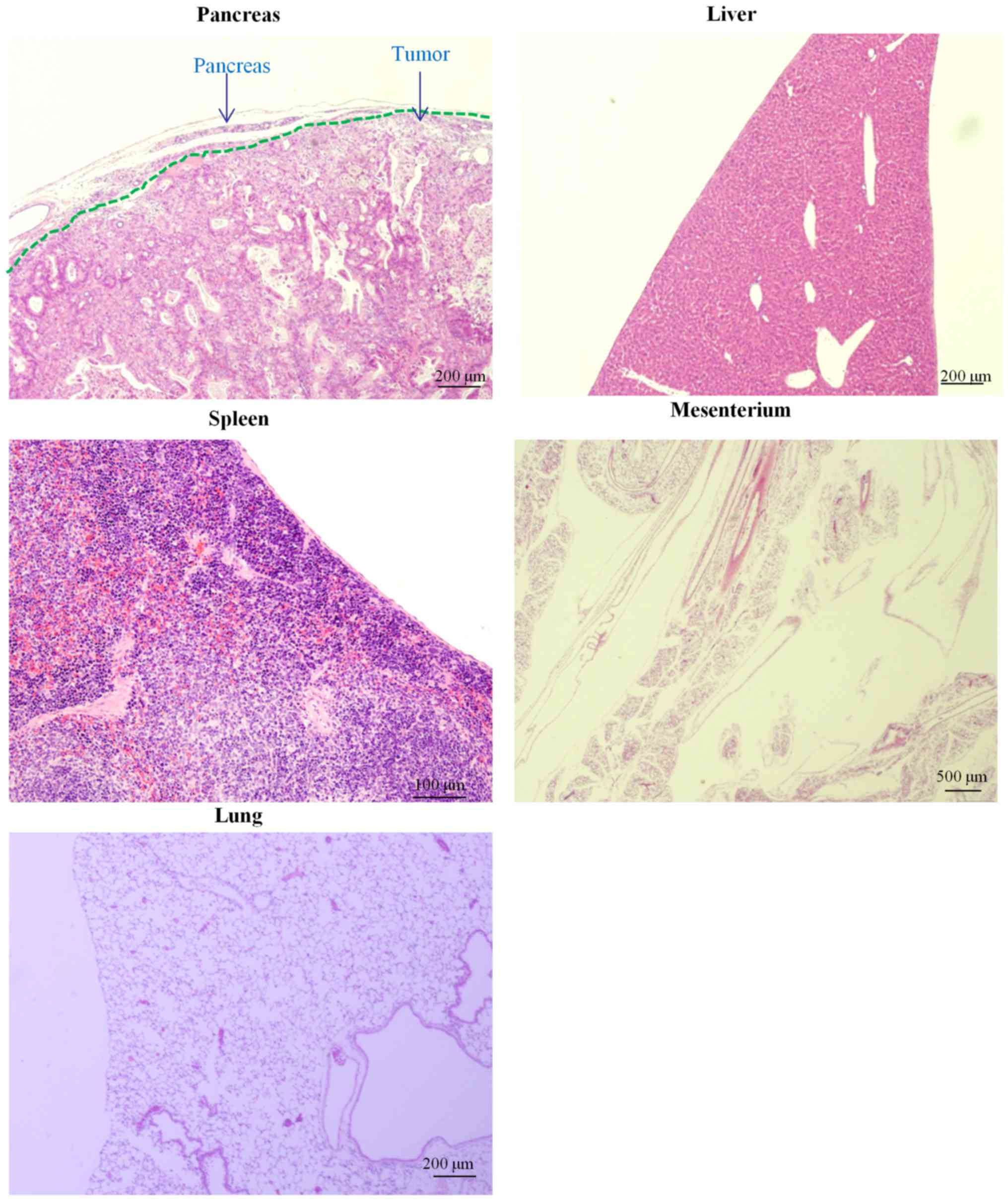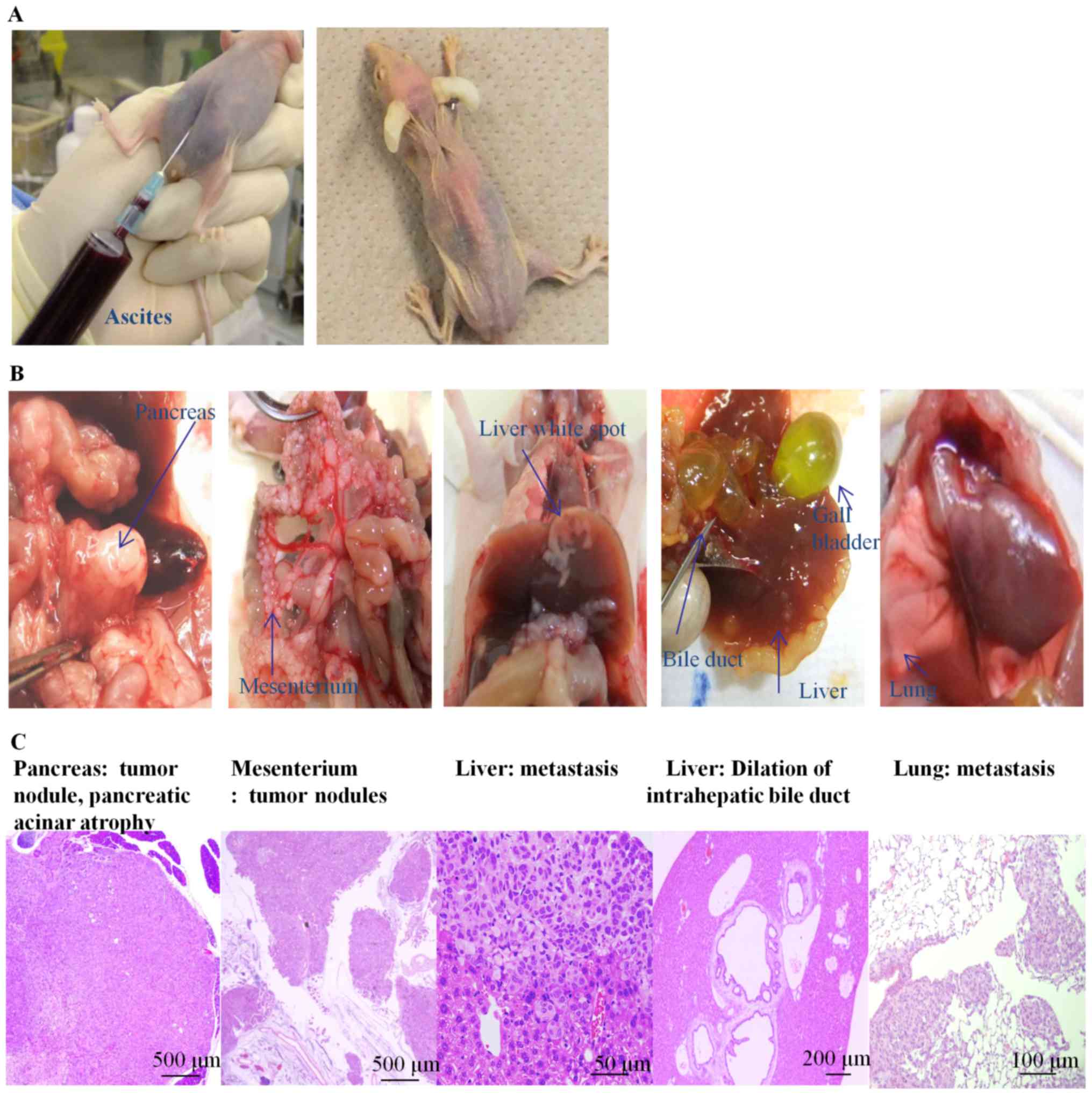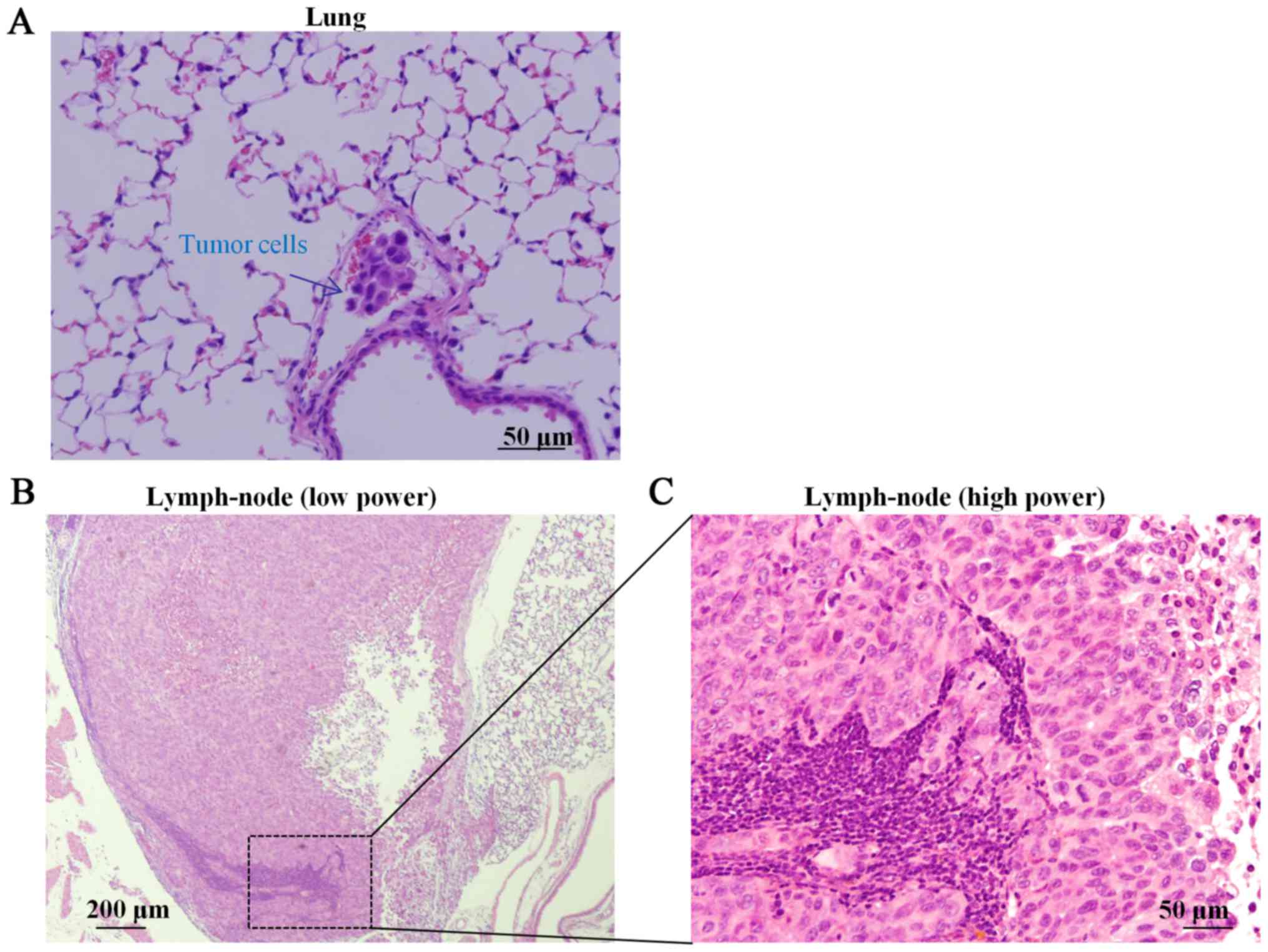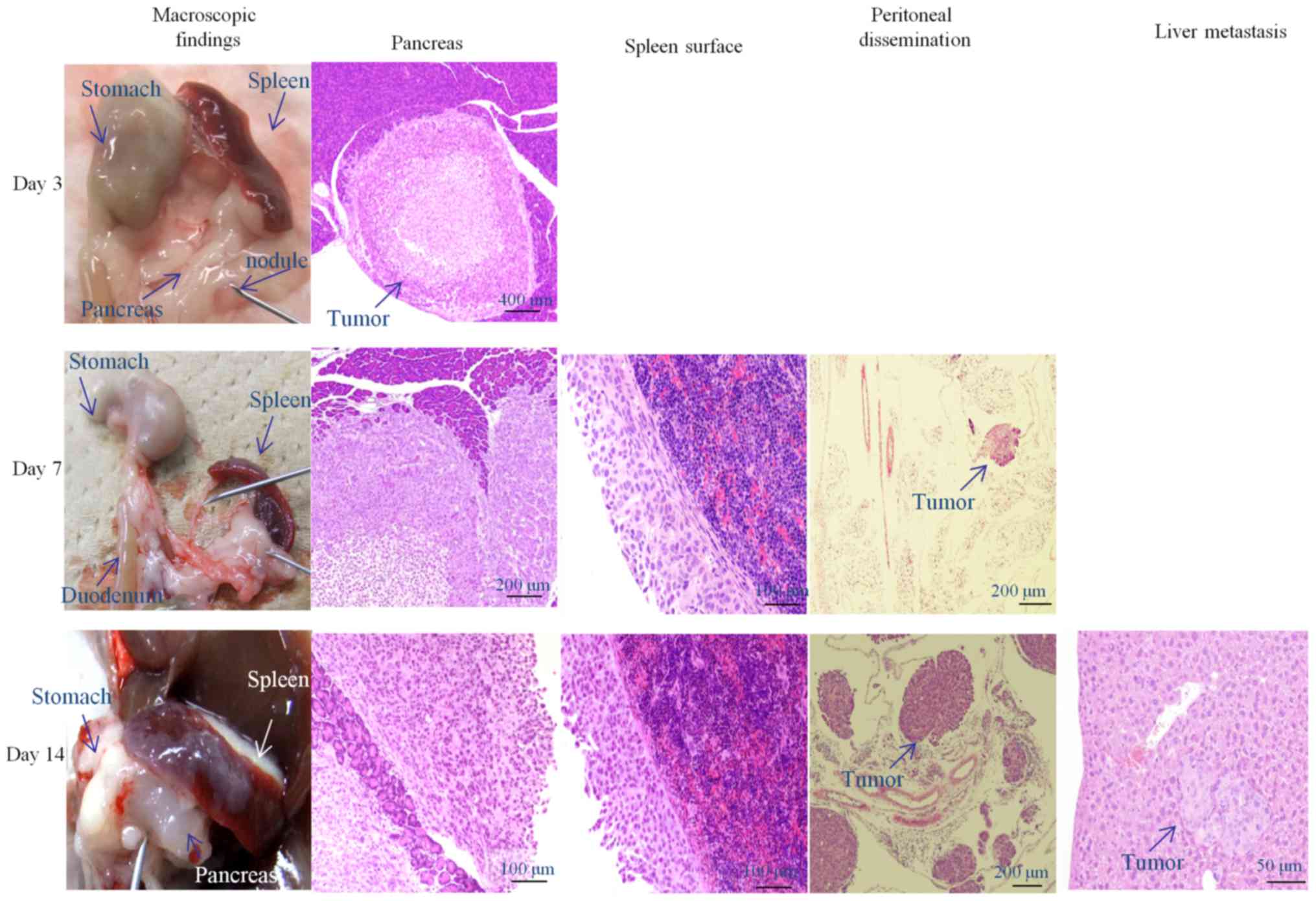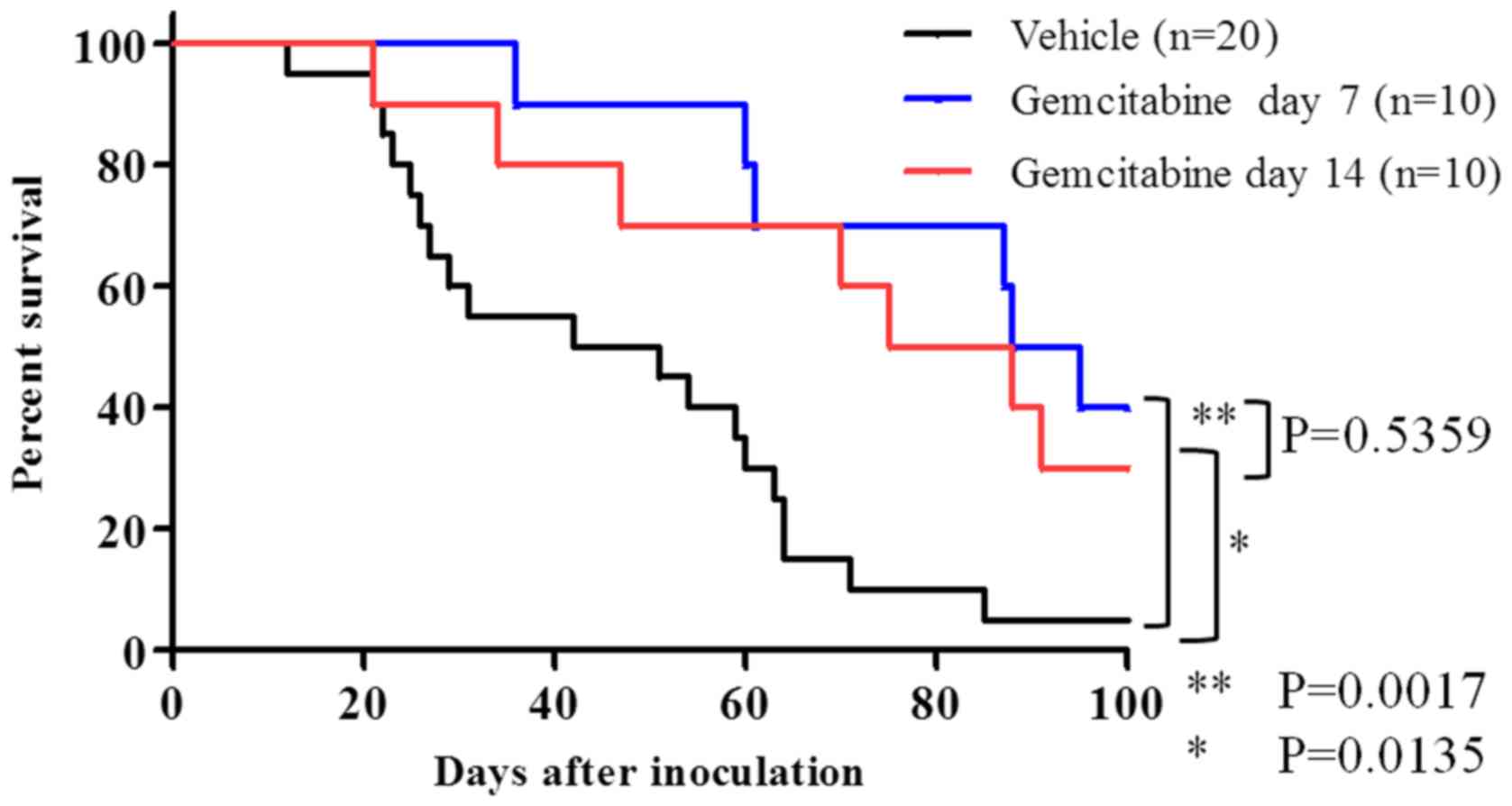Investigation into metastatic processes and the therapeutic effects of gemcitabine on human pancreatic cancer using an orthotopic SUIT‑2 pancreatic cancer mouse model
- Authors:
- Published online on: December 29, 2017 https://doi.org/10.3892/ol.2017.7722
- Pages: 3091-3099
Abstract
Introduction
Patients with pancreatic cancer increase in number every year. Pancreatic cancer is typically associated with extremely poor prognosis. Even with advanced imaging technology and diagnosis, many patients are diagnosed at a stage when the cancer is unresectable. Even if resected, most will eventually metastasize to locations such as the liver or peritoneum (1–3). Improvements in chemotherapy are necessary to improve the prognosis of pancreatic cancer patients (4). Gemcitabine was approved in the United States in 1996 and is a key drug for patients with pancreatic cancer (5). In recent years, gemcitabine has been administered with nab-paclitaxel. Although the survival rate is improved, the prognosis of patients with pancreatic cancer remains grim. In vivo animal models are important for facilitating the rapid development of effective drugs. These models imitate metastatic patterns and allow for close examination of the therapeutic effects of new medications.
Therefore, several mouse models are used, including orothotopically, heterotopically, syngenic, xenografted (6); patient-derived tumor xenografted or genetically engineered cancer models (7,8). These models have varied advantages pertaining to ease, cost, reproducibility, etc. Generally, preclinical drug development examines the effects of the subcutaneous implantation model on tumor regression. Mia-pa-ca-2, Capan-1, and BX-PC-3 are used as models for pancreatic cancer; however, only BX-PC-3 is used as a model for gemcitabine resistance in pancreatic cancer. Our laboratory has not confirmed distant metastasis in models involving subcutaneous implantation of Capan-1 or SUIT-2 cell lines. Therefore, mice that are subcutaneously transplanted with these cells cannot be used to assess drug anti-tumor effects or metastases. Tumor regression effects alone are insufficient for evaluating survival extension and the curability of cancer. There is a need to evaluate drugs in multiple ways, determining if the drug acts on pancreatic tumors, if it suppresses metastases, and if it can improve secondary pathologies.
Among these promising models, we expect orthotopic xenografted pancreatic cancer models to be preferable because the model can evaluate the drug effects on human pancreatic cancer cells and imitate the natural metastatic cascades with high reproducibility and convenience and without special gene engineering technologies or ethical issues related to the use of clinical pancreatic cancer specimens. Previous studies affirm the usefulness of orthotopic xenografted pancreatic cancer model mice in these studies (9–13). There are several pancreatic cancer cell lines, and all cell lines do not metastasize from orthotopically xenografted pancreas, as in the typical course of human pancreatic cancer (14,15). In addition, few studies have examined the cell lines suitable for evaluating drug efficacy when xenografted cells spread from the primary pancreas to the extra-pancreas and distant organs. We also do not know when target drugs should be started in experimental animal models during preclinical testing. Effective drug development requires that we address these experimental problems and examine the systemic pathological, and therapeutic, effects.
The purpose of this study was to establish an ideal pancreatic cancer mouse model for reliable preclinical testing. Such a model will accurately reflect human pancreatic cancer phenotypes and estimate the results of future clinical trials. We focused on the orthotopic pancreatic cancer mouse model using the SUIT-2 cell line because this model has characteristics similar to the progression phenotypes of human pancreatic cancer, with extra-pancreatic invasion, intra-peritoneal dissemination, and hematogenous metastases to other organs. First, we examined the spread of inoculated SUIT-2 cells from primary pancreatic tumors by monitoring the systemic and pathological findings. Subsequently, using the model mice imitating Stage IV human pancreatic cancer, we evaluated the prognostic metastatic inhibition effects of gemcitabine treatment, which was started on day 7 and day 14 after SUIT-2 inoculation. We sought to determine if our focused-SUIT-2 pancreatic cancer model could portray the effects of gemcitabine treatment against typical human metastatic pancreatic cancer cells.
Materials and methods
Cell cultures and animals
Human pancreatic cancer cell lines Capan-1 and SUIT-2 were provided by American Type Culture Collection and the Japanese Cancer Research Resources Bank (Tokyo, Japan). The cells were cultured in DMEM (Gibco; Thermo Fisher Scientific, Inc., Tokyo, Japan) and RPMI-1640 (Gibco; Thermo Fisher Scientific, Inc.) supplemented with streptomycin (100 mg/ml), penicillin (100 U/ml) (Pen strep; Gibco; Thermo Fisher Scientific, Inc.), and 10% fetal bovine serum (FBS) (Gibco; Thermo Fisher Scientific, Inc.) in a humidified incubator with 5% CO2 at 37°C.
We purchased 5-week-old female BALBc nu/nu mice from Japan SLC (Hamamatsu, Japan). These animals were transferred to a temperature-(20–26°C) and humidity-controlled (40–60% relative humidity) room with a 12-h light/12-h dark cycle during the experimental period. All animal experiments were approved by the FUJIFILM Animal Experimentation Committee.
Orthotopic implantation
The cells were treated with trypsin/EDTA (Gibco; Thermo Fisher Scientific, Inc.) and washed with FBS-added and serum-free media twice. Cell suspensions of 1×106 cells/0.01 ml were injected into the pancreatic tail of mice under anesthesia (isoflurane) (Pfizer, Tokyo, Japan). A cotton swab was held over the injection site for 1 min to prevent leakage of intrapancreatic tumor cells. We measured survival times until death or moribundity (e.g., marked decrease in body weight, hypothermia, or other conditions requiring euthanasia).
We orthotopically transplanted Capan-1 and SUIT-2 lines (1×106 cells) into mice (Capan-1 n=8, SUIT-2 n=8) and plotted the Kaplan-Meier survival curve 72 days after transplantation. The mice were sacrificed and examined for tumor spreading through the use of macroscopic and microscopic observations by hematoxylin and eosin (H&E) staining.
To evaluate the time course of metastatic cascades in the orthotopic SUIT-2 model, we made 23 SUIT-2 (1×106 cells) model mice and pathologically examined tumor spreading in each pancreas, spleen surface, peritoneum, liver, and lung on days 3, 7, and 14 after inoculation. H&E sections of the heart, lung, trachea, submandibular gland, aorta, liver, kidney, spleen, pancreas, adrenal gland, peritoneal cavity, bladder, stomach, duodenum, jejunum, ileum, colon, rectum, female genital organs, sternum, lymphatic tissues, and abdominal wall were examined.
Evaluation of gemcitabine effects using the orthotopic SUIT-2 pancreatic cancer model
Overall, 40 BALBc nu/nu mice were orthotopically inoculated with 1×106 SUIT-2 cells (day 0). The mice were randomly divided into three groups: the vehicle group (n=20), gemcitabine day 7 group (n=10, weekly intravenous injection started 7 days after inoculation; 240 mg/kg/week, weekly) (Teva Pharmaceutical Industries Netanya, Israel), and gemcitabine day 14 group (n=10, weekly intravenous injection was started 14 days after inoculation; 240 mg/kg/week, weekly).
For weekly treatment, 240 mg/kg is reported to be the maximal tolerated dose of gemcitabine in mice (16). We plotted Kaplan-Meier survival curves 100 days after transplantation for each group. This treatment was performed until the final observation week excluding death or moribundity. Tumor spreading was evaluated as mentioned above.
H&E stains
Organs and tissues were fixed in 10% neutral buffered formalin (Wako Pure Chemical Industries, Ltd., Osaka, Japan) and embedded in paraffin (Sakura Finetek Japan Co., Ltd., Tokyo, Japan), and 2-µm sections were prepared. The sections were stained with H&E (Hematoxylin 3G, Sakura Finetek Japan Co., Ltd.; Eosin, Wako Pure Chemical Industries, Ltd.) using standard procedures (Hematoxylin, 1 min and Eosin, 1 min). Snapshots of histology were taken using Olympus BX51 microscope. Images were generated using an attached Olympus DP70 camera and the cellSens software (Olympus Corporation, Tokyo, Japan).
Statistical analysis
Overall survival was measured from the day of SUIT-2 injection and plotted according to the Kaplan-Meier method; a log-rank test was used for comparison. P<0.05 was considered to indicate a statistically significant difference. All statistical analyses were performed using the GraphPad Prism5 software package (GraphPad Software, Inc., La Jolla, CA, USA).
Results
The orthotopic SUIT-2 xenografted mouse model resembled the spread of typical human pancreatic cancer compared to the Capan-1 mouse model
Among several human pancreatic cell lines, we selected Capan-1 and SUIT-2 cells for our orthotopic pancreatic cancer mouse model because these cells are transplantable into the mice, and transplanted tumor pathology was relatively similar to that of human pancreatic cancer tissues, with ductal components and cancer stromal components or poor differentiation. Capan-1 and SUIT-2 cells were transplanted orthotopically and observed. Capan-1-transplanted mice (n=8) had no remarkable abnormal findings, including body weight loss, jaundice, or abdominal ascites during the observation period.
Tumor progression in two orthotopic transplantation mouse models of pancreatic cancer were evaluated (Fig. 1). On dissection on day 72 after inoculation, pancreatic cancer nodules were observed in all mice (Fig. 1A). Transplanted Capan-1 cells were observed in all pancreatic tumors (Fig. 2); however, the rate of metastasis was low (50%). SUIT-2-transplanted mice (n=8) began to die or became moribund from day 20 after transplantation. Tumor nodules were scattered over the pancreas to the spleen, mesenterium, and retroperitoneum on necropsy (Fig. 1B). We plotted Kaplan-Meier survival curves for Capan-1- and SUIT-2-inoculated mice. The median survival of SUIT-2-transplanted mice was 46.5 days. This model led to premature death (Fig. 1C). Capan-1-transplanted mice experienced superior prognoses than the SUIT-2-transplanted mice.
To clarify the SUIT-2 spread and the causes of death, dead or moribund mice were subjected to macroscopic and pathological observation (Fig. 3). Many mice had carcinomatous ascites with bleeding. In some mice, the ascites were more than 10 ml (Fig. 3A, left). Jaundiced mice appeared to have yellow-colored skin, noses, and limbs (Fig. 3A, right). Most mice had single SUIT-2 nodules in the pancreas, with adhesion to surrounding organs such as the spleen and the stomach. SUIT-2 cells appeared as white spots and were spread throughout the whole body, including the mesenterium, liver, and lung (Fig. 3B). Some mice had intestinal dilation due to peritoneal dissemination, lymph node metastasis, and pleural effusion (data not shown). SUIT-2 tumors in the pancreas (moderate to poorly differentiated), atrophy of pancreatic acinar cells, mesenteric tumors, hepatic metastases, and lung metastases were observed using microscopic observations of the SUIT-2 model mice (Fig. 3C). Jaundiced mice displayed bile duct dilation (Fig. 3C). Tumor cells (Fig. 4A) were observed in the blood vessels of the lung, and lymph node metastases to the mediastinum were also observed by pathological examination of the whole body (Fig. 4B and C).
SUIT-2 spread from the pancreas to the extra-pancreatic tissues, including distant organs, in sacrificed mice
To investigate cancer spread following transplantation, 23 mice were sacrificed on days 3, 7 and 14 after transplantation. Representative examples are shown in Fig. 5. The microscopic findings and metastatic rates are summarized in Table I. At sacrifice 3 days after inoculation, we observed pancreatic nodules, covered with a transparent membrane. Microscopic examination showed nodule tumor cell formation, covered by a membrane. Tumor cells were not observed in other organs.
Table I.Establishment of microscopic SUIT-2 tumors in the orthotopic pancreatic cancer mouse model according to the observation time. |
At sacrifice, 7 days after inoculation, white nodular areas were observed on the surfaces of the stomach, spleen, and peritoneum, surrounding the transplanted pancreas. Pancreatic tumors invaded the pancreatic acinar cells (70%), with spleen capsule surface thickening and cancer cell seeding. Cancer cells were observed in the mesenterium but not in other organs. At this time, we observed 40% peritoneal dissemination. At sacrifice on day 14 after inoculation, a large nodule from the inoculated pancreas invaded the surrounding tissues, and we observed white tumor spots on the surfaces of the spleen and stomach. Microscopically, tumor cells disseminated throughout the abdominal cavity over the pancreatic serosa. Tumor cells were seeded in the capsule of the spleen, as on day 7. Peritoneal dissemination was 60% at this time. Many tumor nodules were observed in the mesenterium, with 40% liver metastases. Lung metastases were not observed on any specimens; however, tumor cells in the blood vessels of the lung and mesenteric lymph vessels (30%) were noted (data not shown).
Efficacy of gemcitabine using an orthotopic pancreatic cancer model
Survival tests were performed on gemcitabine, a standard treatment for pancreatic cancer. Weekly gemcitabine treatment occurred on day 7 and day 14 after cell transplantation. A survival-prolonging effect was observed in the groups receiving gemcitabine as compared with that in the group receiving the vehicle (Gemcitabine day 7; P=0.0017) (Gemcitabine day 14: P=0.0135; Fig. 6). Median survivals were 46 days for the vehicle group, 91.5 days for the gemcitabine day 7 group, and 81.5 days for the gemcitabine day 14 group. Mice who died during the test in both the vehicle group and gemcitabine-administered groups were dissected and examined.
All mice displayed a wide range of metastatic cancer cells (data not shown). Surviving mice treated with gemcitabine were dissected on day 100 (Table II). Comparing the day 7 treatment group with the day 14 treatment group, earlier treatment was slightly inhibitory to both liver and lung metastases (day 7: 67%, and day 14: 100%). In both groups, pancreatic tumor invasion, peritoneal dissemination, liver metastases, and lung metastases increased on dissection (day 100), in spite of surviving mice.
Table II.Macroscopic and microscopic SUIT-2 tumors in survival mice on the last observation day according to the starting date of gemcitabine administration. |
Discussion
The SUIT-2 orthotopic pancreatic cancer model was similar to the phenotypic progression of human pancreatic cancer, with extra-pancreatic invasion, intra-peritoneal dissemination, and other hematogenous organ metastases, compared to the Capan-1 model.
Pathology results clarified when these metastatic lesions spread from primary pancreatic tumors. The prognostic efficacy of gemcitabine treatment against metastatic pancreatic cancer lesions, similar to Stage IV human pancreatic cancer, was also evaluable using this model. Moreover, necropsy on the final observation day showed the suppression of distant metastases in the day 7 treatment group compared to that in the day 14 group. However, all mice displayed xenografted tumors in spite of the continuous gemcitabine treatment, similar to typical human pancreatic cancer.
The SUIT-2 orthotopic pancreatic cancer mouse model has been used in other studies for evaluating promising new anticancer agents (14,17–20). Cherubini et al (17) used the model to evaluate target drug survival effects. Saimura et al (19)evaluated the tumor reduction effects by measuring tumor weight in a mouse model. SUIT-2 is reported not only in an orthotopic but also in a subcutaneous model, a peritoneal dissemination model, and a lung metastasis model. Previous studies evaluated the anti-tumor effects in a subcutaneous implantation model, drug effects on peritoneal dissemination in a dissemination model, and anti-tumor effects in a lung metastasis model (21,22). In this study, we used 30-G thin needles and 10 µl of cell suspension for orthotopical injection into the pancreas to prevent these cells from leaking into the abdominal cavity after inoculation. As shown in Table I, spreading of the macroscopic tumors into the abdominal cavity was not observed on day 3, which is similar to early human pancreatic cancer. We closed the pancreatic puncture holes by pressing the punctured tissue using cotton swabs for 1 min. This process may be effective for reproducing early pancreatic cancer in an orthotopic mouse model. On the other hand, some model mice had the SUIT-2 spreading in the extra-pancreatic area, including pancreatic surface and abdominal cavity, on day 7 despite our procedures using cotton swab. It is suggested that small number of SUIT-2 cells are leaked into the extra-pancreatic areas in a part of mice. To exclude this possibility, it may be effective to use Matrigel for cell suspension and to press the puncture holes using swab for more long interval.
The orthotopic mouse model can be used to mimic the natural course of human pancreatic cancer metastases. However, few researchers have reported on the spreading patterns of systemic pancreatic cancer, including invasion, peritoneal dissemination around the pancreas, and distant metastases. Our model indicated that orthotopically-injected SUIT-2 cells sequentially spread from the pancreas to the peritoneum, diaphragm, liver, and lungs, similar to human pancreatic cancer. We validated this model's ability to mimic the terminal stage of pancreatic cancer with hemorrhagic ascites, tumor cell metastases, liver failure with jaundice, intussusception, and pleural effusion. This experimental mouse model was similar to human pancreatic cancers.
We sought to identify the best mouse model for predicting the effects of anticancer drugs in humans. Many mouse models may not reflect human clinical trial results. For instance, ganitumab, aflibercept, and exatecan reportedly induce strong anticancer effects without severe side effects in preclinical mouse models. However, the agents could not show the similar effect in human cancer patients during clinical trials (11,23,24). Our model accurately mimics the action of gemcitabine in human pancreatic cancers. This mouse model can reproduce the anticancer effects from a single gemcitabine treatment, including survival prolongation, because all mice that survived to day 100 had cancer and displayed limited anticancer effects, similar to the gemcitabine effects in human patients with pancreatic cancer. If new investigational agents can cure pancreatic SUIT-2 cells in this mouse model, the agent may be useful for treating human pancreatic cancer. In other words, using this model, it may be possible to predict drug effects within clinical trial contexts, contributing to efficient drug development.
We believe that our mouse model correctly reflects the drug efficacy of gemcitabine alone therapy in the clinic because the monotherapy could not eradicate SUIT-2 cells spreading to the whole body. In future, we want to examine the drug efficacy of gemcitabine combined therapy using our model because the combined therapy with gemcitabine and nab-paclitaxel has often been used as a standard chemo-regimen for advanced pancreatic patients.
In this model, metastases form throughout the whole body, and cancer death results from causes such as liver failure and peritoneal dissemination. This model may not be suitable for evaluating drug effects against conditions such as liver metastases. Previous studies describe the peritoneal dissemination model by intra-peritoneal injection, the liver metastasis model by splenic injection or direct liver injection, and the lung metastasis model by tail vein injection for preclinical studies of pancreatic cancer (25). Such models can evaluate drug effects on peritoneal dissemination, liver metastases, and lung metastases. After evaluating the effects of survival prolongation and organ-specific anti-tumor effects, using our orthotopic mouse model, it might be better to use the abovementioned specific metastasis mouse model to understand the therapeutic characteristics of the target drugs against organ metastases. Moreover, our model has another limitation: our nude mice have activity of macrophases and natural killer cells to prevent the cancer spreading. In future, we hope to establish the orthotopic pancreatic cancer model using specific mice with humanized immunoreactivity (26,27) and to investigate the metastatic cascades and the therapeutic efficacy of new drug candidates using our model.
In conclusion, there are prior reports of the SUIT-2 orthotopic pancreatic cancer mouse model for evaluating tumor volume or survival time. We clarified the process and timing of pancreatic cancer progression in this mouse model, similar to that observed in typical human pancreatic cancer patients. Through this model, researchers can validate the prognostic and therapeutic efficacy of gemcitabine as a key drug for treating human pancreatic cancer. Future investigations may further affirm the use of this model as a standard model for drug development.
Acknowledgements
The authors thank Hiroyuki Iwamura, Akira Inomata, Takeshi Yamaura, Shinji Mima, Hiroki Nishikawa, Hiroko Fujisaki and Hiroko Nemoto for helpful discussion and technical assistance. We also thank the staff at Biotechnical center Japan SLC for providing technical help with the animal experiments.
References
|
Okusaka T, Matsumura Y and Aoki K: New approaches for pancreatic cancer in Japan. Cancer Chemother Pharmacol. 54 Suppl 1:S78–S82. 2004.PubMed/NCBI | |
|
Takahashi H, Ohigashi H, Gotoh K, Marubashi S, Yamada T, Murata M, Ioka T, Uehara H, Yano M and Ishikawa O: Preoperative gemcitabine-based chemoradiation therapy for resectable and borderline resectable pancreatic cancer. Ann Surg. 258:1040–1050. 2013. View Article : Google Scholar : PubMed/NCBI | |
|
Oberstein PE and Olive KP: Pancreatic cancer: Why is it so hard to treat? Therap Adv Gastroenterol. 6:321–337. 2013. View Article : Google Scholar : PubMed/NCBI | |
|
Gnanamony M and Gondi CS: Chemoresistance in pancreatic cancer: Emerging concepts. Oncol lett. 13:2507–2513. 2017. View Article : Google Scholar : PubMed/NCBI | |
|
Burris HA III, Moore MJ, Andersen J, Green MR, Rothenberg ML, Modiano MR, Cripps MC, Portenoy RK, Storniolo AM, Tarassoff P, et al: Improvements in survival and clinical benefit with gemcitabine as first-line therapy for patients with advanced pancreas cancer: A randomized trial. J Clin Oncol. 15:2403–2413. 1997. View Article : Google Scholar : PubMed/NCBI | |
|
Kapischke M and Pries A: Animal models of pancreatic cancer for drug research. Expert Opin Drug Discov. 3:1177–1188. 2008. View Article : Google Scholar : PubMed/NCBI | |
|
Aguirre AJ, Bardeesy N, Sinha M, Lopez L, Tuveson DA, Horner J, Redston MS and DePinho RA: Activated Kras and Ink4a/Arf deficiency cooperate to produce metastatic pancreatic ductal adenocarcinoma. Genes Dev. 17:3112–3126. 2003. View Article : Google Scholar : PubMed/NCBI | |
|
Bardeesy N, Aguirre AJ, Chu GC, Cheng KH, Lopez LV, Hezel AF, Feng B, Brennan C, Weissleder R, Mahmood U, et al: Both p16(Ink4a) and the p19(Arf)-p53 pathway constrain progression of pancreatic adenocarcinoma in the mouse. Proc Natl Acad Sci USA. 103:pp. 5947–5952. 2006; View Article : Google Scholar : PubMed/NCBI | |
|
Ma L and Saiyin H: LSL-KrasG12D; LSL-Trp53R172H/+; Ink4flox/+; Ptf1/p48-Cre mice are an applicable model for locally invasive and metastatic pancreatic cancer. PLoS One. 12:e01768442017. View Article : Google Scholar : PubMed/NCBI | |
|
Hoang NT, Kadonosono T, Kuchimaru T and Kizaka-Kondoh S: Hypoxia-inducible factor-targeting prodrug TOP3 combined with gemcitabine or TS-1 improves pancreatic cancer survival in an orthotopic model. Cancer Sci. 107:1151–1158. 2016. View Article : Google Scholar : PubMed/NCBI | |
|
Sun FX, Tohgo A, Bouvet M, Yagi S, Nassirpour R, Moossa AR and Hoffman RM: Efficacy of camptothecin analog DX-8951f (Exatecan Mesylate) on human pancreatic cancer in an orthotopic metastatic model. Cancer Res. 63:80–85. 2003.PubMed/NCBI | |
|
Bouvet M, Wang J, Nardin SR, Nassirpour R, Yang M, Baranov E, Jiang P, Moossa AR and Hoffman RM: Real-time optical imaging of primary tumor growth and multiple metastatic events in a pancreatic cancer orthotopic model. Cancer Res. 62:1534–1540. 2002.PubMed/NCBI | |
|
Ammons WS, Wang JW, Yang Z, Tidmarsh GF and Hoffman RM: A novel alkylating agent, glufosfamide, enhances the activity of gemcitabine in vitro and in vivo. Neoplasia. 9:625–633. 2007. View Article : Google Scholar : PubMed/NCBI | |
|
Tomioka D, Maehara N, Kuba K, Mizumoto K, Tanaka M, Matsumoto K and Nakamura T: Inhibition of growth, invasion, and metastasis of human pancreatic carcinoma cells by NK4 in an orthotopic mouse model. Cancer Res. 61:7518–7524. 2001.PubMed/NCBI | |
|
Metildi CA, Kaushal S, Hoffman RM and Bouvet M: In vivo serial selection of human pancreatic cancer cells in orthotopic mouse models produces high metastatic variants irrespective of Kras status. J Surg Res. 184:290–298. 2013. View Article : Google Scholar : PubMed/NCBI | |
|
Veerman G, Ruiz van Haperen VW, Vermorken JB, Noordhuis P, Braakhuis BJ, Pinedo HM and Peters GJ: Antitumor activity of prolonged as compared with bolus administration of 2′,2′-difluorodeoxycytidine in vivo against murine colon tumors. Cancer Chemother Pharmacol. 38:335–342. 1996. View Article : Google Scholar : PubMed/NCBI | |
|
Cherubini G, Kallin C, Mozetic A, Hammaren-Busch K, Müller H, Lemoine NR and Halldén G: The oncolytic adenovirus AdΔΔ enhances selective cancer cell killing in combination with DNA-damaging drugs in pancreatic cancer models. Gene Ther. 18:1157–1165. 2011. View Article : Google Scholar : PubMed/NCBI | |
|
Kizaka-Kondoh S, Itasaka S, Zeng L, Tanaka S, Zhao T, Takahashi Y, Shibuya K, Hirota K, Semenza GL and Hiraoka M: Selective killing of hypoxia-inducible factor-1-active cells improves survival in a mouse model of invasive and metastatic pancreatic cancer. Clin Cancer Res. 15:3433–3441. 2009. View Article : Google Scholar : PubMed/NCBI | |
|
Saimura M, Nagai E, Mizumoto K, Maehara N, Okino H, Katano M, Matsumoto K, Nakamura T, Narumi K, Nukiwa T and Tanaka M: Intraperitoneal injection of adenovirus-mediated NK4 gene suppresses peritoneal dissemination of pancreatic cancer cell line AsPC-1 in nude mice. Cancer Gene Ther. 9:799–806. 2002. View Article : Google Scholar : PubMed/NCBI | |
|
Houghton JL, Zeglis BM, Abdel-Atti D, Aggeler R, Sawada R, Agnew BJ, Scholz WW and Lewis JS: Site-specifically labeled CA19.9-targeted immunoconjugates for the PET, NIRF, and multimodal PET/NIRF imaging of pancreatic cancer. Proc Natl Acad Sci USA. 112:pp. 15850–15855. 2015; View Article : Google Scholar : PubMed/NCBI | |
|
Takiguchi S, Inoue K, Matsusue K, Furukawa M, Teramoto N and Iguchi H: Crizotinib, a MET inhibitor, prevents peritoneal dissemination in pancreatic cancer. Int J Oncol. 51:184–192. 2017. View Article : Google Scholar : PubMed/NCBI | |
|
Fukushima T, Kawaguchi M, Yamasaki M, Tanaka H, Yorita K and Kataoka H: Hepatocyte growth factor activator inhibitor type 1 suppresses metastatic pulmonary colonization of pancreatic carcinoma cells. Cancer Sci. 102:407–413. 2011. View Article : Google Scholar : PubMed/NCBI | |
|
Beltran PJ, Mitchell P, Chung YA, Cajulis E, Lu J, Belmontes B, Ho J, Tsai MM, Zhu M, Vonderfecht S, et al: AMG 479, a fully human anti-insulin-like growth factor receptor type I monoclonal antibody, inhibits the growth and survival of pancreatic carcinoma cells. Mol Cancer Ther. 8:1095–1105. 2009. View Article : Google Scholar : PubMed/NCBI | |
|
Gaya A and Tse V: A preclinical and clinical review of aflibercept for the management of cancer. Cancer Treat Rev. 38:484–493. 2012. View Article : Google Scholar : PubMed/NCBI | |
|
Bruns CJ, Harbison MT, Kuniyasu H, Eue I and Fidler IJ: In vivo selection and characterization of metastatic variants from human pancreatic adenocarcinoma by using orthotopic implantation in nude mice. Neoplasia. 1:50–62. 1999. View Article : Google Scholar : PubMed/NCBI | |
|
Ishikawa F, Yasukawa M, Lyons B, Yoshida S, Miyamoto T, Yoshimoto G, Watanabe T, Akashi K, Shultz LD and Harada M: Development of functional human blood and immune systems in NOD/SCID/IL2 receptor {gamma} chain(null) mice. Blood. 106:1565–1573. 2005. View Article : Google Scholar : PubMed/NCBI | |
|
Shultz LD, Ishikawa F and Greiner DL: Humanized mice in translational biomedical research. Nat Rev Immunol. 7:118–130. 2007. View Article : Google Scholar : PubMed/NCBI |



